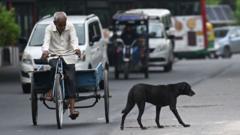Delhi has been given an eight-week deadline by India's Supreme Court to capture and relocate its estimated one million stray dogs to designated animal shelters. This ruling follows increasing concerns over rising instances of dog bites and the associated rabies threat. Municipal sources point out that the cities of Noida, Ghaziabad, and Gurugram are also experiencing a surge in stray dog populations.
India is home to millions of stray dogs and accounts for approximately 36% of global rabies-related fatalities, according to the World Health Organization. In a recent statement, the court emphasized that "infants and young children, not at any cost, should fall prey to rabies," aiming to instill confidence in public safety among residents.
The court has ordered the establishment of several shelters across Delhi and its suburbs, with the capacity to house a minimum of 5,000 dogs each and equipped with sterilization, vaccination facilities, and CCTV monitoring. Moreover, the ruling prohibits the release of sterilized dogs back into public spaces, despite existing protocols permitting this practice. A helpline for reporting dog bites and potential rabies cases must also be implemented within a week.
However, animal welfare organizations have expressed strong opposition to the court’s directive, labeling the timeline given as unrealistic. Animal rights activist Nilesh Bhanage, founder of the PAWS group, argues that many Indian cities lack the necessary infrastructure to accommodate and care for stray dogs properly, with fewer than 1% of the required shelter capacity currently available.
Meanwhile, the reported cases of dog bites in India reached 3.7 million in 2024, illustrating a critical public health concern. The World Health Organization estimates that rabies causes between 18,000 to 20,000 deaths annually in India, though the true numbers remain difficult to ascertain. Contrarily, government records indicate 54 rabies fatalities in 2024, a slight increase from 50 the previous year, highlighting the need for effective measures to manage the situation and protect public safety.



















